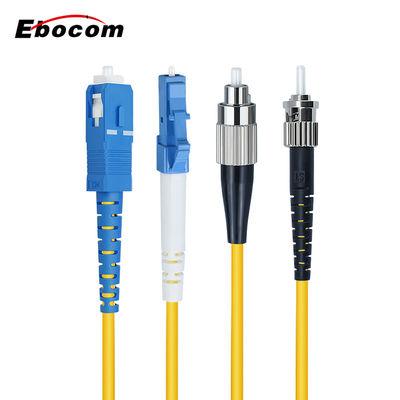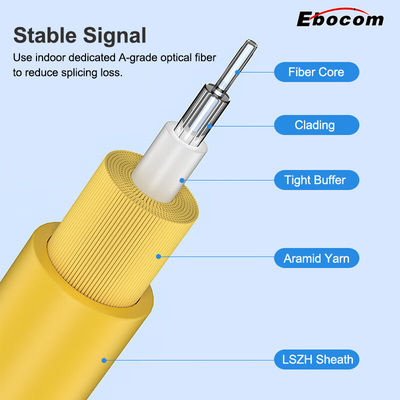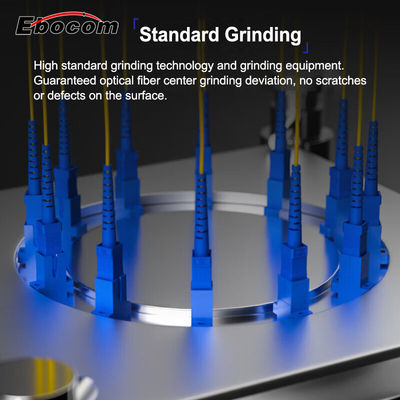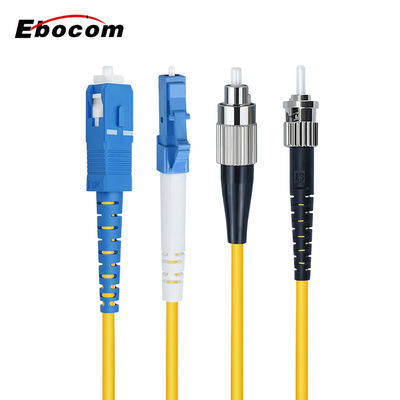G652D G657A1 Fiber Patch Cord

Contact me for free samples and coupons.
WhatsApp:0086 18588475571
WeChat: 0086 18588475571
Skype: sales10@aixton.com
If you have any concern, we provide 24-hour online help.
x| Connector | SC, LC, FC | Insertion Loss | ≤ 0.2 DB |
|---|---|---|---|
| Feature | Low Insertion Loss | Diameter | 2.0mm/3.0mm |
| Jacket Color | Yellow (can Customize As Color Code) | Fiber Brand | YOFC, ZTT, FIBERHOME |
| Fiber Connector | FC, LC, SC, ST | Fiber Type | SM G652D/G657A1/G657A2 (support MM OM1 OM2 OM3 OM4) |
| Highlight | 3.0mm Fiber Patch Cord,100m Fiber Patch Cord,G657A1 Fiber Patch Cord |
||
Fiber Patch Cord With SC/LC/FC Connector APC UPC PC Polishing low Insertion Loss OD 2.0mm 3.0mm Simplex G652D G657A1 length 1m 3m 5m 10m 100m
Product Description:
Optic Fiber Patch Cord
The optic fiber patch cord serves as a detachable connection that links optical fibers. Its role is to accurately connect the two end faces of optical fibers, allowing the maximum output of light energy emitted by the optical fiber to be coupled to the receiving optical fiber. This minimizes any impact to the system resulting from its intervention in the optical link.
With its precise connection, the optic fiber patch cord ensures that the transmission of information is not affected by losses. Instead, it offers a smooth transition between the optical fibers. As a detachable connection, it provides flexibility in various applications and allows for easy connection and disconnection to other optical devices.
The optic fiber patch cord is an essential component in optical fiber communication, where it finds application in multiple fields, including telecommunications, data centers, and network systems. Its reliability, precision, and speed make it a preferred choice over other types of connections such as copper cables or wireless communication.
Features:
There are several distinguishing features of these connectors:
- They come in different types of connectors to suit different needs.
- The connectors are available in three different polish types: PC, APC, and UPC.
- They offer low insertion loss and high return loss, ensuring less signal loss on transmission.
- These connectors are designed for repeated insertion and removal, and they are very user-friendly.
- They are available in two cable diameter sizes: 2.0mm and 3.0mm
Each of these features ensures that the connectors are versatile and adaptable to different settings and needs. Additionally, the high-performance and user-friendly design make them an attractive option for those in need of dependable and easy-to-use connectors. The different polish types accommodate for different signal transmission requirements, while the low insertion loss and high return loss ensure that signals are transmitted with minimal distortion. The availability of different cable diameter sizes further adds to the versatility of these connectors, making them an attractive option for a wide range of applications.
Technical Parameters:
Insertion loss is a critical specification in ensuring the performance of a fiber optic system. It refers to the amount of power lost when light waves travel through the system's components. The industry standard for insertion loss is ≤0.2dB, which means that only 0.2% of the input light power is lost.
Return loss is another key parameter in fiber optic systems. It measures the amount of light reflected back from a component or connector, which can cause signal degradation or even failure. The higher the return loss, the better. For PC connectors, the minimum return loss requirement is 45dB, while UPC connectors should have at least 50dB return loss. The highest standard is 60dB for APC connectors, which are commonly used in high-end applications such as telecommunication networks.
The temperature range is also an important consideration in fiber optic design and installation. The typical operating temperature range is from -40℃ to +80℃, which covers a wide range of environmental conditions. Extreme temperature variations can cause irreparable damage to the fiber optic components, so it's crucial to choose the right materials and components that can withstand the temperature fluctuations.
Technical Parameters:
| Mode Type | Single Mode | Multi-Mode |
| Grinding | UPC/APC/PC | PC |
| Insertion loss | ≤0.2dB | ≤0.3dB/0.5dB |
| Return Loss | PC≥45dB UPC≥50dB APC≥60dB | / |
| Repetitive | ≤0.2dB | |
| Interchangeability | ≤0.2dB | |
| Temperature Range | -40℃~+80 ℃ | |
(Remark: The above parameters are for reference only)
Applications:
Applications of optical fiber include a wide range of industries and areas, such as:
- Fiber optic communication systems for transmitting information over long distances through optical fibers that use light as the transmitting medium.
- Local area networks (LANs), data centers, and cable television (CATV) all make use of optical fiber to provide high-speed data transmission.
- Optical fiber testing equipment, in order to evaluate and measure the performance of optical fiber cables and systems.
- Telecommunication networks, including both commercial and residential applications, to transmit data and voice signals.
Optical fibers offer significant advantages over traditional copper or coaxial cables, including greater bandwidth, longer distances of transmission, and resistance to electromagnetic interference. As a result, optical fiber has become a preferred choice for many high-speed communications applications.
In addition, advancements in optical fiber technology continue to drive the development of new applications and industries. These include military and defense applications, medical equipment, and sensing technologies such as distributed temperature sensing and distributed acoustic sensing.
Overall, the versatility and reliability of optical fiber make it an essential component in many critical communication systems and technological advancements. As our world becomes more connected and data-driven, the importance of optical fiber technology only continues to grow.
FAQ:
Q1: What is the brand of the Patch Cord?
A1: The brand of the Patch Cord is Ebocom/OEM.
Q2: Where is the Patch Cord manufactured?
A2: The Patch Cord is manufactured in China.
Q3: What certifications does the Patch Cord have?
A3: The Patch Cord has ISO 9001 and TLC certifications.
Q4: What is the minimum order quantity for the Patch Cord?
A4: The minimum order quantity for the Patch Cord is 1000 pcs.
Q5: What is the price range for the Patch Cord?
A5: The price range for the Patch Cord is between 0.33-0.50 USD/piece.
Q6: How is the Patch Cord packaged?
A6: The Patch Cord is packaged in plastic bags and cartons.
Q7: What is the delivery time for the Patch Cord?
A7: The delivery time for the Patch Cord is 5-10 days, normally.
Q8: What are the payment terms for the Patch Cord?
A8: The payment terms for the Patch Cord are TT in advance.
Q9: What is the supply ability for the Patch Cord?
A9: The supply ability for the Patch Cord is 2000 pcs/day.












